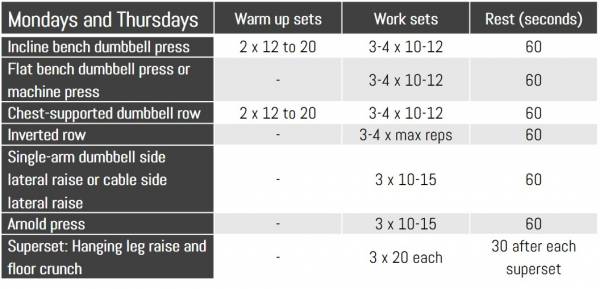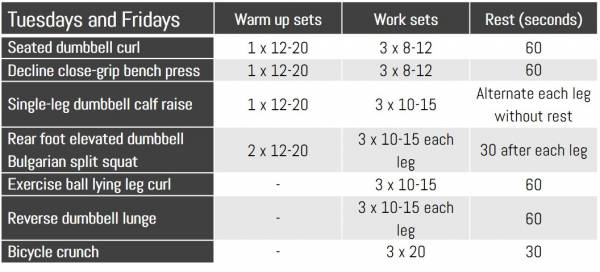The 40-something crowd today is more active than ever. And I don’t mean slow strolls on the treadmill, or lifting tiny, colorful dumbbells at the neighborhood wellness center. Many quadragenarians are finding their second wind, while others never stopped. Turning the big four-zero is no longer the beginning of the end, as our parents treated it; with an aggressively active lifestyle, 40 can really be the new 20.
But even as many are finding that fitness is not the sole province of the young, there are a few precautions you need to take as father time has sneakily crept in. Here, you’ll find a few principles needing some attention as you embark on a new era of your training.
If you’re reading this, you likely fall into one of two general camps:
- You’ve lifted for a few years, have some experience under your belt, and are in need of a few pointers about how to adjust your training.
- You’re brand new to resistance training, and need a quick primer on the unexplored terrain.
Here are a few things for both camps to consider at 40 and beyond.
Understand What You’re Up Against
If you’re the typical 40-year-old, you have a full-time job, a family, and other social obligations that preclude you from attending to training as you once did at 20. You now have a busier lifestyle and unpredictable schedule complications. There’s a good chance that you want to accomplish with your training has shifted as well. You no longer wish to be the biggest, baddest dude in the gym. You simply want to add some muscle, lose some fat, and do it all pain-free.
Comparing yourself to (potentially much younger) fellow gym members is a potential pitfall. But the onslaught of gym bros on social media can also play with your head. You were once young too, and got away with sketchy things in the gym. But allow the wisdom of your age to overpower your ego and nostalgia. Don’t go down the black hole of following others as they throw caution to the wind—especially those 20 years your junior.
We all know (and bemoan) that our metabolisms slow as we age. Beyond putting on a few pounds, this will have a direct effect on your recovery ability. But that isn’t a death sentence. You can still practice habits to get optimal results and improve metabolism, recovery, and progress. If you’re the seasoned lifter, you’ll have the advantage of only needing to tweak a few things, since you’ve built a solid foundation. On the other hand, if you’re a newbie, you’ll need to develop healthy and effective habits from the start, so that you can reap some big rewards and stay injury-free.
Find Your Fire and Keep It Burning
Even though you may no longer desire to be the big man on campus, you will still need to draw your motivation from somewhere. Whatever your goals, from losing weight, to adding muscle, to just becoming more mobile, your motivation needs to be alive and well in order to optimally progress. Clearly defining your goals will go a long way to solidifying that motivation. Get down to brass tacks and detail your plan of attack. Set specific mini-goals, such as losing five pounds of fat or gaining three pounds of muscle per month.
While you’re defining those goals, ensure that they are both realistic and attainable. In the post-forty landscape, you aren’t likely to win Mr. Universe, but you can make significant progress and improve your physique and overall wellbeing. Just set forth realistic and achievable goals, and take it step by step.
To keep making progress toward your goals, you first have to stay healthy. That means no skipping pre-workout warm ups and post-training mobility. Whether you’ve been in the iron game for years or are new to the resistance training arena, you’ll need to make a habit of performing a pre- and post-workout routine for all major areas that are susceptible to tightness and injury.
Don’t get caught up in programs with unnecessary complexity and movements that defy all logic. Whether you’re 20 or 40, the basics still work. After four decades of wear and tear, your body might ask you to make a few adjustments to some exercises, but the principles still remain the same. The big, multi-joint compound lifts coupled with progressive programming are ageless, universal principles. For example, if you find you suffer from lower back painduring heavy barbell back squats, a sensible replacement would be rear foot elevated Bulgarian split squats. Barbell presses can be replaced by dumbbell presses. Chest-supported rows and inverted rows can replace bent-over rows.
Whatever your situation, there is always a workaround, and that has to include fitting your workouts into your normal life. One of the mistakes that every young lifter makes is to only train under perfect circumstances. When outside factors like a shift in schedule, abnormal eating patterns, or less than optimal training equipment get in the way, they feel “off,” and tend to inadvertently give it less than their best effort. As we get older, these wrenches in the machine happen more often. You need to learn to be flexible with your training so that you can apply the same discipline and determination no matter what the circumstance.
The Build Muscle After 40 Program
Below is an example of a training program designed for the 40+ crowd. It includes all of the factors listed above. Whether you’re an experienced lifter looking to wipe the slate clean and start fresh, or a late-starting newbie who wants to kick things off the right way, this is for you.
This program can easily fit into four days out of every week, such as Mondays, Tuesdays, Thursdays, and Fridays. You can either treat Wednesdays and the weekends as rest days, or partake in a recreational activity or active recovery such as walking, jogging, swimming, or biking. You can choose any schedule you like, just make sure you aren’t training more than two days consecutively.
End each day with a thorough stretching session, and perform the program for 4-6 weeks. After that, either take a week off from training but remain active, or cut back on volume and intensity for a week before restarting the program.
Warm Up
Before each workout, perform two rounds of 10 reps each of the following circuit:
- Squat jump
- Push up
- Alternating lunge
- Inverted row
- Bicycle crunch








